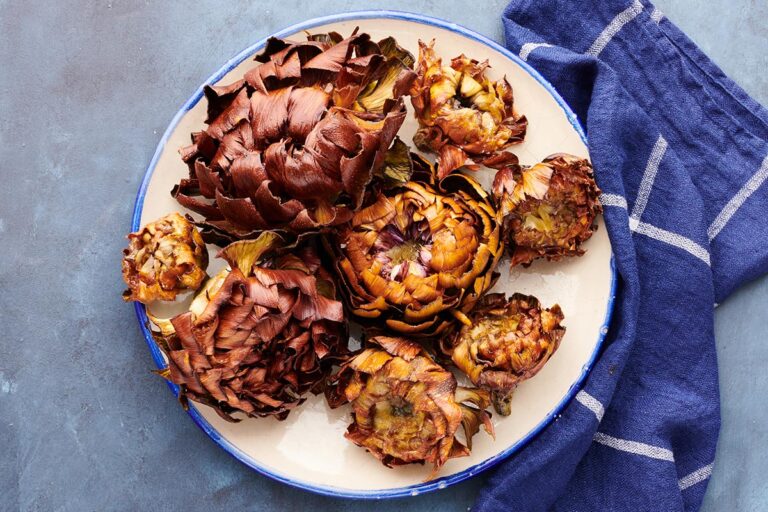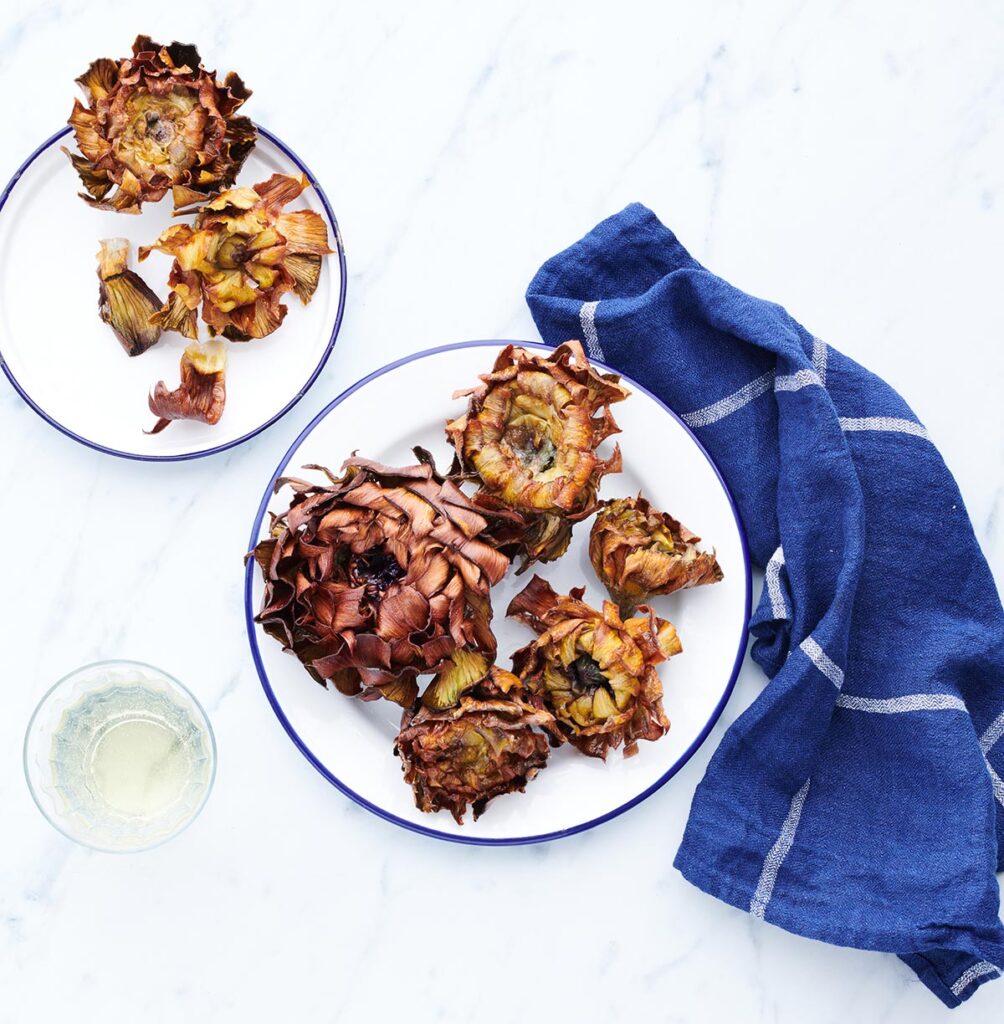
Although I was born and raised in Italy, specifically within Milan’s Jewish community, I had never tasted the quintessential Jewish dish of carciofi alla giudia (“Jewish-style artichokes”), until years after moving to the United States in 2005.
So, during my first visit back to Rome in 2017, I made it a point to dine at Ba Ghetto. This renowned kosher restaurant is famous for its Roman-Jewish specialties, especially the fried artichokes that have become a staple of cucina Ebraica-Romanesco (Jewish-Roman cuisine).
Let me be clear: the buzz surrounding this dish is entirely justified. Crispy on the outside and soft on the inside, carciofi alla giudia release an aroma that teases your palate long before your first bite.
What are Jewish-style fried artichokes?
Let’s start with the basics. Carciofi alla giudia are deep-fried artichokes that are very simply seasoned with salt and, at times, a squeeze of lemon.
While there isn’t concrete written evidence, many culinary scholars believe that the dish was traditionally prepared for Passover. “That would make sense because of the overlap with the seasonality of the vegetable,” Jewish Italian food writer and photographer Benedetta Guetta, the author of Cooking alla Giudia: A Celebration of the Jewish Food of Italy, told me.
Even more specifically, the dish is thought to have originated in Rome’s Jewish ghetto between 1555 and 1870. During that era, papal decrees imposed restrictions on Jews, preventing them from enjoying certain “luxuries,” including ingredients available within their living quarters.
Artichokes were among the foods allowed for Jews. In addition, according to Ghetta, non-Jewish Italians were historically less familiar with the vegetable and therefore hesitant to consume it.
“The Jews were connected to the Arab world, and that’s likely how they knew about the ingredient and felt comfortable using it,” she explained.
The frying technique central to carciofi alla giudia, Guetta explained, likely traces back to the common Jewish profession within the ghetto.
Many Jews were street food vendors, one of the few professions they were permitted to pursue.
“They would sell scraps and bits and pieces of food that were fried,” which were relatively easy to prepare given limited cooking methods, Guetta said. This frying method also ensured the food appealed to a broad range of palates.
The kashrut laws, which prohibit mixing dairy and meat, also influenced culinary choices in the ghetto. Butter was largely eschewed in favor of olive oil, which is exactly what is used to fry carciofi alla giudia.
How to make carciofi alla guidia
The dish might seem straightforward, but recreating it elsewhere can be a challenge — largely due to the specific artichokes that Italian chefs source in the country.
“Carciofi alla giudia are traditionally made with a specific kind of artichoke that’s grown in Lazio, a central Italian region,” Guetta said. “You can make the dish with other artichokes, but it just won’t come out the same.”
In Italy, chefs favor the mammola, a unique, round artichoke known for its delicate texture, unlike the typical tougher artichoke varieties. Guetta noted that many chefs freeze these specific artichokes, which grow only during the Spring, to use for the dish year-round.
To recreate the dish in the U.S., she recommends using purple artichokes, one of the softest varieties available. You should also trim away much of the outer leaves and stems — “otherwise they will be very hard and chewy,” Guetta said.
But the magic of carciofi alla giudia doesn’t solely lie in its ingredients or how they’re prepared. The deep frying is not just about taste — it’s about the sensory experience it evokes.
Of course, the fact that the artichokes are deep-fried makes them absolutely delicious. Yet, one bite reveals that there’s something more to it — it’s not just about the oil that the vegetable is drenched in.
Whether it’s the recommended squeeze of lemon before indulging or the combination of the soft interior and crispy exterior, carciofi alla giudia always hit the spot. This dish doesn’t only taste good — it’s a visual treat.
“We eat with our mouths but also with our eyes,” Guetta said of the Roman-Jewish delicacy. It’s no surprise, she added, that her publisher chose the dish for her cookbook’s cover.
To make carciofi alla giudia at home, try Guetta’s recipe below. But first, some advice: enjoy them immediately after preparation. Don’t treat them as a side dish but savor them as their own course. Squeeze a bit of lemon on top or eat them plain. Dive in — you’re in for a treat.
The following recipe is excerpted from “Cooking alla Giudia” by Benedetta Jasmine Guetta (Artisan Books). Copyright © 2022.

Carciofi alla giudia
PrintIngredients
- 1 lemon, halved
- 4 medium or 8 baby artichokes
- Extra-virgin olive oil for deep-frying
- Kosher salt
- Freshly ground black pepper
- Lemon wedges for serving (optional)
Instructions
- Fill a 1-quart bowl with water and squeeze the juice of the lemon into it.
- Remove the tough outer leaves of one artichoke to expose the more tender leaves within and then, using kitchen shears or a paring knife, cut off the top half of each leaf. Trim the base and peel the stem, then scoop out the hairy choke in the center of the artichoke with a sharp spoon (if possible) and discard. Once all the cutting and trimming is done, the artichoke should look like a rosebud. Place the artichoke in the lemon water. Repeat with the remaining artichokes.
- When all the artichokes are trimmed, drain and pat dry. One at a time, put the artichokes on a clean work surface and press down on them gently to force the leaves to open; alternatively, use your fingers to spread out the leaves.
- In a medium saucepan, heat the olive oil over medium heat until it reaches 300°F on a deep-fry thermometer. You can check the oil temperature by dipping the handle of a wooden spoon in it — when the oil is ready, it will gently sizzle and bubble up around it. Drop a couple of artichokes at a time into the hot oil and press them down with a fork or with tongs. Cook for 5 to 10 minutes, depending on the size.
- Transfer the half-cooked artichokes to a plate lined with paper towels to drain and repeat with the remaining artichokes. Using a fork or your fingers, try to separate the leaves of the artichokes so they open up like a flower.
- Raise the heat and bring the oil to 350°F to fully fry and crisp up the artichokes.
- Fry the artichokes one at a time: add the artichoke stem side up to the hot oil and cook for 3 to 4 minutes, then flip it with kitchen tongs and fry until the leaves brown, pressing the artichoke gently down into the oil so that it opens up like a flower. Transfer to a plate lined with paper towels to drain.
- Once the artichokes have cooled slightly, sprinkle them with salt and pepper. Serve immediately, with a few slices of lemon on the side, if desired.
Originally Published Aug 17, 2023 05:54PM EDT
